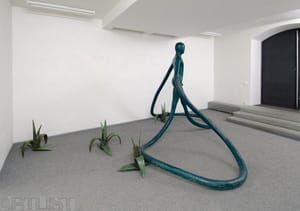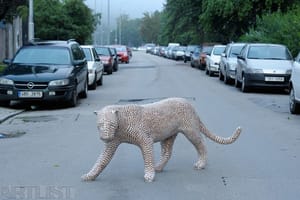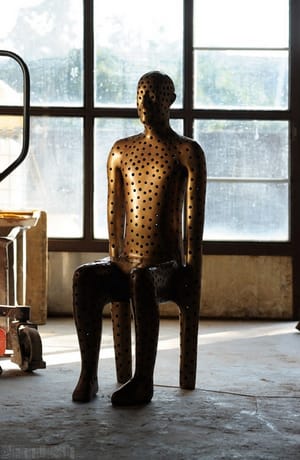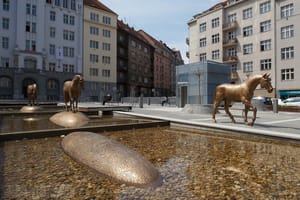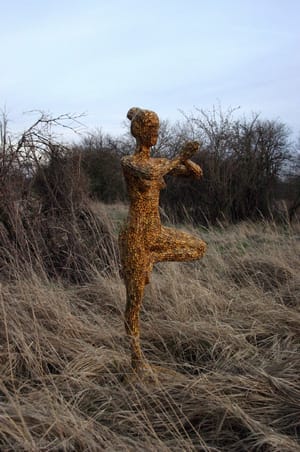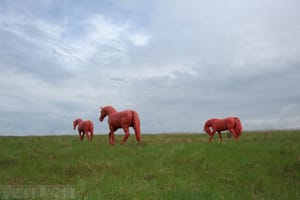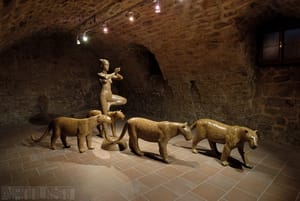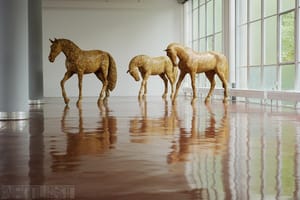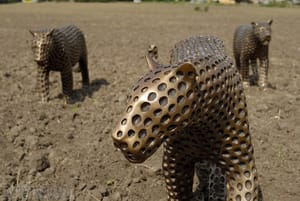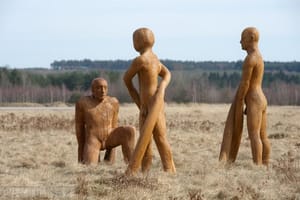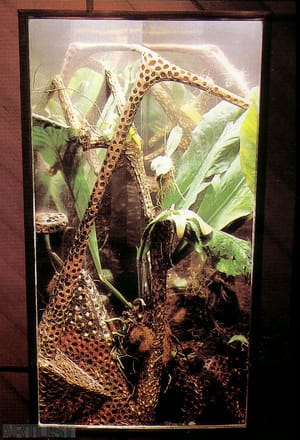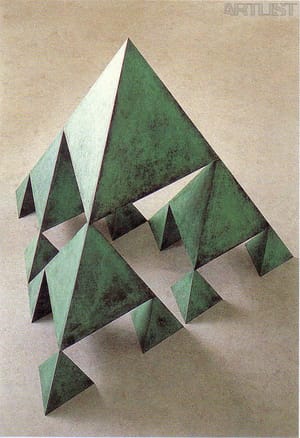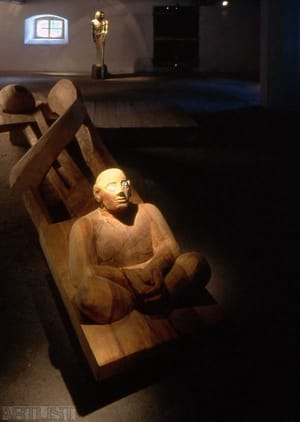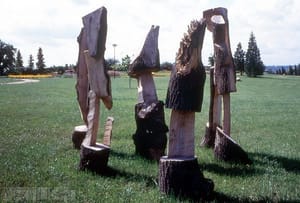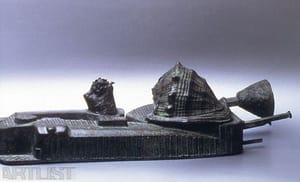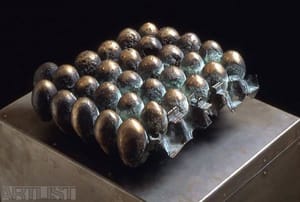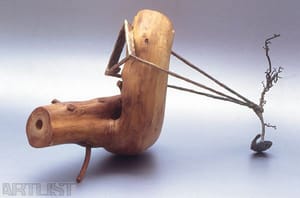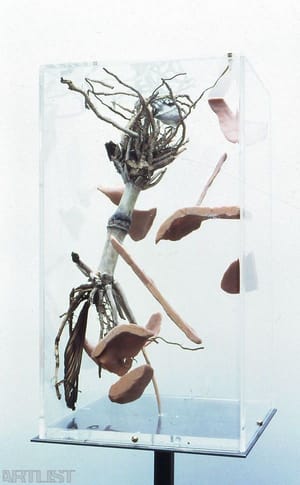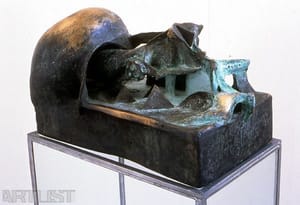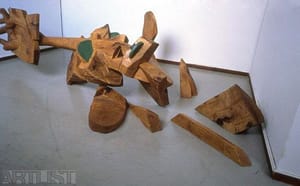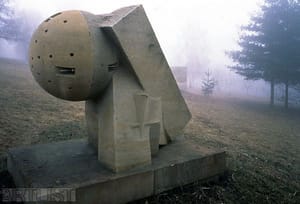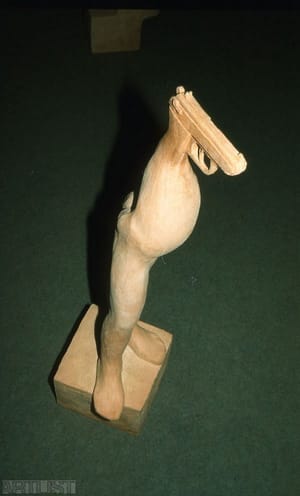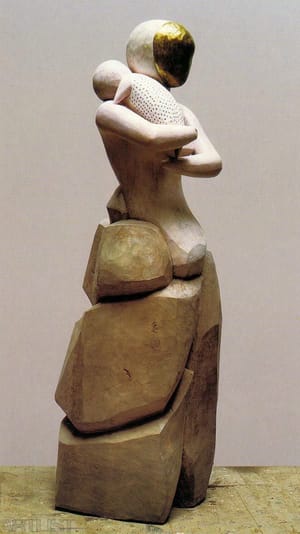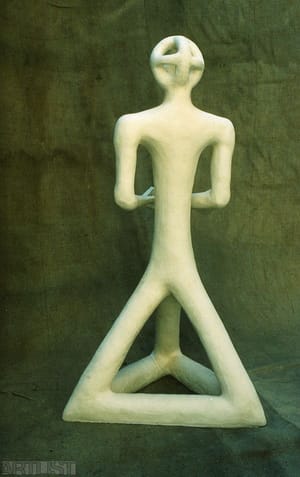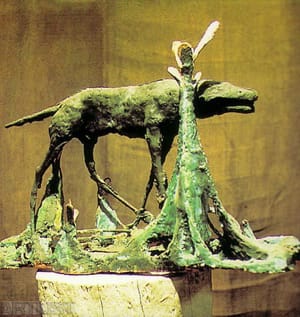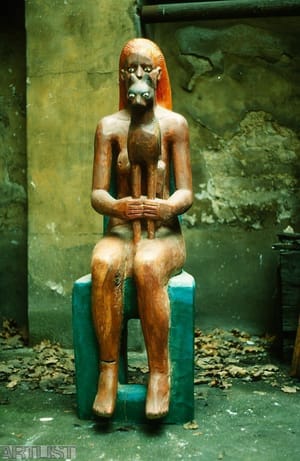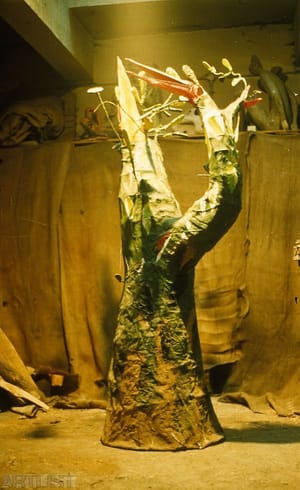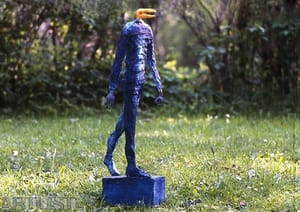- First Name
- Michal
- Surname
- Gabriel
- Born
- 1960
- Birth place
- Prague
- Place of work
- Prague
- Website
- www.michal-gabriel.cz
- i-datum
- ↳ Find in the VVP AVU database
- Keywords
- CSU Library
- ↳ Find in the catalogue
About artist
Michal Gabriel came on to the scene in the early 1980s and became one of the most strikingly postmodern artists. Postmodern expression was inherent in Gabriel’s work both in his first spontaneous phase of neo-expressionism, as well as in the second eclectic phase of reflected expression. From the beginning of his artistic activities we witness his absorbing narration of stories through the specific means of sculpture language. The fact that clay, paper, wood and a wide range of other materials can change in his hands into a sensitive and meaningful means of communication had for Gabriel a fascinating appeal and decisive influence. At the same time, however, he explicitly distances himself from “reckless” expression of spontaneous modelling: “... this material (paper, textile, wire) does not allow me to do what clay does: I don’t work with it that easily and so before I start working I have to know for sure what I'm going to do and not start with the notion that what ever isn't clear I'll just replace with modelling." (M.G.)
Following his strong neo-expressional fairytale figures of bird-men and other creatures of the unbound imagination modelled predominantly from wire and multi-coloured paper, his free sculpture language calms into wooden, ceramic, bronze and laminated sculptures and acquires gravity. The spontaneous and yet concentrated sense for the expressive possibilities of each detail is enriched by the need to tell an exciting story. Egyptian Girl (1985), Bird (1987), Scribe (1987) and Pegasus (1988) are examples of Gabriel’s artistic development, in which a spontaneous neo-expressive narrative gradually is gradually complicated by reflection on the expressive possibilities and specifics of the sculpture language.
After 1986 Gabriel, like other artists of his generation, began to realise that the hitherto communicativeness and comprehensibility of neo-expressionist stories is limited to the social group of generation types and interest in the possibility of a universal pictorial language and in the mystery of the communicability of personal expression moved to the foreground.
Compositions that the artist creates using a sensitive understanding of the composition of forms from “public" shapes such as biscuits, plastic doll moulds and moulds of other children’s toys express this tension between personal decision-making of the work and manipulation with provocatively impersonal nature of certain elements. In large sculptures created from tree trunks, the organic world of wood and of the sensitive sculptor's chisel that becomes familiar with the material contends with the impersonal nature of geometric shapes and language codes such as the alphabet (Strom 1994). The fact that in life various “language systems” exist side-by-side is reflected by compositions joining different materials and different “sentences” in one whole ( ).
Reflection on social co-existence in works, in which doubt is cast upon the possibility of assuming a single dominant position of perception, is related to this. The content of such a sculpture message is not an expression of a personal position identical with itself, but is the product of personal experience that alone can be understood as a fragment of the whole. The non-culminating nature of a sculpture composition is a sensitive expression of the impossibility to culminate personal experience, however deep it goes, since with the increasing depth of personal experience the experience of the social individual distances itself from the other pole that is communication and the agreed language system. Michal Gabriel also expressed his social experience verbally in a text at an exhibition at MXM Gallery in 1993 in which he describes the experience of falling off a cliff: during the fall he feels as if he's getting smaller. It’s as if the person falling experienced it through the eyes of another person observing the fall from the top of a cliff. The artist expresses here the experience of irreconcilable tension confirmation and denial of the dominant “I” position.
A similar tension between the identity of person experience and the experienced aimlessness of language systems is also expressed by the glass boxes in which objects are assembled so that their content and spatial arrangement prevent an understanding from a single view. Another variation of essentially the same tension is in the bronze landscapes. The bronze, sensitively damascened surface offers an adventure of a rich, distinct shape that evokes the infinite development of the personal imagination, but also shows its other, veristic, unimaginative side when we realize that the rich shape is the actual casting of a shrivelled pumpkin.
In his work since the end of the 1990s we see in Gabriel’s work the maturation of all previous phases of artistic experience in an organic synthesis. The works show the certainty of sculptural form that can reliably transform organic floral and faunal shapes so that in the tension between reality and its sculptural variant the specifics of both contexts emerges in the foreground, encouraging the view to reflect on the fact that human understanding is a complicated, never-ending adventure.
One other important characteristic of Gabriel’s work is worth mentioning. That is of creative freedom that provides the impetus for innovation and non-traditional sculpturing. In the beginning that was wire and paper, live polychromes, glass applications, laminate, objets trouvés, walnut shells and many other original materials and working methods. Often at exhibitions there appeared objects that brought to mind installations rather than sculptures. But these expressive means and non-traditional approaches were always subjugated to the sculptor’s view; meaning the artist who, as it was emphasised, works with reflections on the relation of the human body to its surroundings. The use of electronic elements in the sculpture is enabled by an awareness that in its relations to the universe the human body is a medium in which all possibilities are potentially contained. Organically among them is the use of electronic light and moving lighting effects, as well as the incorporation of the digital transmission of an image to the sculpture.
Michal Gabriel is not a philosopher speculating about human life; he’s a sculptor, yet his sculptures are not autotelic aesthetic artefacts, but are an expression of a sensitive human experience and of its maturation, and this gives all his works to date a clear and admirable consistency.
- Author of the annotation
- Ludvík Hlaváček
- Published
- 2007
CV
Studies:
1980-87 studies at the Academy of Fine Arts, Prague, sculpture studio
1978-82 studies at School of Applied Arts, Prague
Employment:
2007 Dean of the Faculty of Visual Arts in Brno
2001 senior lecturer at the Academy of Applied arts, architecture and design in Prague
1998 senior lecturer at the Faculty of Visual Arts, Brno University of Technology, Brno
1998 Head of the Studio of Figurative Sculpture
Awards:
1995 Jindřich Chalupecký´s Prize
Other:
1987 founding member of the Tvrdohlaví (Stubborn) art group
- Member of art groups included in ARTLIST.
Exhibitions
- Solo exhibitions
-
2015
Na zemi a na zdi, bistro no. 19, Karolíny Světlé 19, Praha 1
Michal Gabriel, Městská galerie Vlastimila Rady Železný Brod
Černobílá – bíločerná galerie Magna, Bieblova 3 , Ostrava
Kaskáda 2015 Michal Gabriel , sochy na hladině
2014
Trutnov – sochy v ulicích Květen - září, Galerii města Trutnov M. Gabriel, V, Paluš, O. Bílek
Michal Gabriel - sochy, Muzeum v Bruntále
Legendy - Galerie Dvorak Sec, Florentinum Praha
Michal Gabriel - sochy, Galerie Dolní brána, Prachatice
Michal Gabriel - Země voda vzduch, Východočeská Galerie v Pardubicích
2013
Sochy na golfovém hřišti Kaskáda 2 Jinačovice u Brna, květen 2012 — květen 2013
Sochy, Galerie Aspekt, březen 2013
Sochy, spolu s Martinem Skalickým a Michalem Šmeralem,Galerie ARS Veselá 39, Brno 7.3. - 29.3.
sochy a kresby, Galerie Maldoror, Přemyslova 9, Praha 2, 21.5. - 29.6.
Predátor, Muzeum keramiky v Bechyni, Alšova Jihočeská Galerie 3.8.- 30.9.
2012
Sochy, výstava v galerii Mona Lisa v Olomouci
Michal Gabriel Sochy, Galerie Konírna v Lipniku n. B.
Pastevci gepardů, výstava soch ve výběhu gepardů v Pražské ZOO
2011
Michal Gabriel - Sousoší - Výstavní síň Sokolská 26, Ostrava
2010
Michal Gabriel Sochy, Artpro galéry, Praha
Michal Gabriel, Galerie Města Trutnova, kurátorka Mgr. Lucie Pangrácová
Hráči na nábřeží, exteriérová exposice na nábřeží v Trutnově, kurátorka Mgr. Lucie Pangrácová
Michal Gabriel, Sochy,Galerie na půdě, Vrchlabí
Michal Gabriel - Sochy, galerie ASPEKT Brno
2009
Dreming I., Kotelna Karlin Gallery,M. Gabriel - sculptures, J. Macht - photography
Michal Gabriel Súsošia 6.LGPMB - liptovská galeria petra michala bohuňa v liptovskom mikuláši, kurátorka Elen Porubanová
Michal Gabriel Sochy, Galerie Kaple, Valašské Meziříčí
Michal Gabriel – Sochy z cyklu Hráči, Výstavní síň Synagoga,
Hranice na Moravě, kurátor Renata Skřebská
2008
Michal Gabriel – Sochy, Galerie ARS, Brno
2006
Sousoší, Galerie města Plzně, Plzeň, kurátor Václav Malina
Zahrada, Galerie Via Art, Praha
Gabriel & Casua (Sochy & architektura), Galerie Chodovská tvrz, Praha, kurátor Martina Pachmanová
2004/5
Ještěrka, instalace v Krajské vědecké knihovně-Spacium, Liberec, kurátor Ivona Raimanová
2004
Michal Gabriel-Tomáš Medek, Galerie ARS, Brno, kurátor Josef Chloupek
Sochy, Galerie moderního umění, Hradec Králové, kurátor Tomáš Rybička
2003/4
Michal Gabriel-Barbora Šlapetová-Lukáš Rittstein, Galerie Tvrdohlaví, Palác Lucerna, Praha
2002
Sochy - obrazy (s Miladou Gabrielovou), Galerie 8A, Brno
2000
Sochy - obrazy (s Janem Mertou), Obecní galerie Malostranská beseda, Praha
Se světlem, Galerie Malá Špálovka, Praha, kurátor Jaroslav Krbůšek
1998
Michal Gabriel a Vladimír Kokolia, Výstavní síň Emila Filly, Ústí nad Labem,
kurátoři Michal Koleček a Petr Svoboda
Sochy (se Stefanem Milkovem), Galerie Sirius Design, Praha
Sochy, animace (spolupráce Josef Švanda), Galerie Caesar, Olomouc, kurátor Miroslav Schubert
1997
Sochy, Galerie Die Aktualität des Schönen..., Liberec, kurátor Zdeněk Primus
Sochy, animace (spolupráce Josef Švanda), Galerie MXM, Praha
1996/7
Michal Gabriel a Vladimír Kokolia, Výstavní síň Emila Filly, Ústí nad Labem,
organizátoři Unie výtvarných umělců a SCSU Praha
1995
Sochy, Galerie hl. m. Prahy-Staroměstská radnice, Praha, kurátor Olga Malá
Bronz, Centrum kultury a vzdělávání, Moravská Ostrava a Přívoz, kurátor Milan Weber
Cena Jindřicha Chalupeckého '94, Galerie Václava Špály, Praha, kurátor Mahulena Nešlehová
Michal Gabriel-Stanislav Libenský a Jaroslava Brychtová, Síň pod Plečnikovým schodištěm, Rajská zahrada Pražského hradu, Praha, organizátor Nadace Svoboda
1994
Michal Gabriel - sochy - Martin Mainer - obrazy, Pavilon Alter botanischen Garten, Mnichov, Německo, kurátor Inge Lindemann
Rožnovské sochařské léto (s Jiřím Plieštikem a Stefanem Milkovem),
Galerie Městské knihovny, Rožnov pod Radhoštěm, kurátor Aleš Žanta
Nové tendence (s Petrem Písaříkem a Petrem Lysáčkem),
Vlastivědné muzeum, Šumperk, kurátor Pavla Teglová
Plastiky, obrazy a práce na papíře (s Igorem Minárikem a Petrem Veselým),
hrad Sovinec, kurátor Petr Nedoma
1993
Sochy, Galerie Aspekt, Brno
Sochařská tvorba, Galerie MXM, Praha
1992
Sochy, Galerie MXM, Praha
1991
Sochařská tvorba, Galerie Malovaný dům, Třebíč
Věty v prostoru, Galerie Pi-Pi-Art, Praha, kurátor Milena Slavická
1989
Sochařská tvorba (s Petrem Sládkem a Erikou Bornovou),
Okresní vlastivědné muzeum, Český Krumlov, kurátor Pavel Zadražil
1988
Sochařská tvorba, Galerie Na bidýlku, Brno, kurátor Karel Tutsch
- Group exhibitions not included in ARTLIST.
-
2015
17. salon architektů a inženýrů, Ministerstvo Kultury Praha 1 Malá strana
Skupinová výstava 8 gallery Prvního pluku 6, Karlín
Galériea Statua Pálffyho palác, Zámocká 47, Bratislava, AS 1 Študenti Michala Gabriela
Tvrdohlaví, Galerie Miroslava Kubíka, Litomyšl
Sculpture line, Praha
Kroměříž Sochy v zahradě
Transmise, Topičův klub, Národní 9, Praha 1
Art safari 30, Studio Bubec Praha 5 Řeporyje
Silver Lining, NG Veletržní palác NG v Praze
2014
3D printshow New York, Metropolitan Pavilion
AS 1 - výstava Ateliéru Socha 1, Galerie Města Trutnova 13.3. - 14.4., kurátor L. Pangrácová
AS 1 - galerie Sýpka - červenec - srpen
Sochy v ulicích - Galerie Města Trutnova květen - září, kurátor L. Pangrácová
Království za koně, Galerie Města Pardubic, kurátor M. Vítková
2013
sochy v ulicích České Budějovice
2012
Digitální sochy v Brně — Dům umění města Brna
Umělci Prahy 6 / Umělci Praze 6, Bayereuth — Německo
Beaufort 04, Belgie, sochařské mezinárodní trienále na pobřeží
2011
Umění ve městě - město české Budějovice
Theatre Mundi - galerie kritiků Praha
GHMP - Sochy v parku Trojského zámku - Praha 7
Digitální sochy - DOX Praha
2010
Venku, Galerie Klenová a Kunstverein Passau, kurátor Marcel Fischer
Postavy, galerie ARTPRO aula VŠE Praha
Cena J. Chalupeckého - laureáti 20 let, DOX, kurátorka L. Lindaurová
2009
Od sadry k žuvačke - autorské techniky a strategie, Nitranská galérie, kurátorka Barbora Gerža
Sochy v ulicích, Město Brno a Dům umění města Brna
Návrhy jezdecké sochy Jošta Moravského, Galerie, Radnická 2, Brno
Štúdio Pelechov-tavená skleněná plastika, Slovenské národné múzeum, Bratislava
Hráči, Galerie moderního umění v Hradci Králové, kurátorka Mgr. Martina Vítková
Hráči, Wortnerrův dům Alšova Jihočeská Galerie, České Budějovice, kurátorka Mgr. Martina Vítková
ART SAFARI 18 sochařské studio Bubec, Praha
2008
Exotismy, Galerie výtvarného umění v Hodoníně, kurátorka Alena Potůčková
Exotismy, Východočeská Galerie v Pardubicích
Exotismy, Galerie výtvarného umění v Chebu
V. Nový zlínský salon, Krajská Galerie výtvarného umění ve Zlíně
Fauna Flora, Gallery Rajatila - Tampere, Finsko, kurátor Vlasta Čiháková Noshiro
Fauna Flora, Galerie Kritiků Praha, kurátor Vlasta Čiháková Noshiro
Neviděný svět, Staroměstská radnice Křížová chodba
Tvrdohlaví po 20 letech, České muuzeum výtvarných umění v Praze, kurátorka Marie Bergmanová
Mezi zvířetem a květinou, Galerie Klatovy/Klenová
2007
Výstavy pro Prahu 1, Galerie La Fame, Praha 1
10 Salon Obce Architektů, Letohrádek královny Anny Belveder - Pražský Hrad
Exotismy, České Muzeum Výtvarných Umění v Praze, kurátorka Alena Potůčková
Tvrdohlaví po 20 letech, Galerie výtvarného umění v Ostravě
2006
Podvědomí, Galerie Millennium, Praha, organizátor Obecní galerie Beseda - Sdružení občanů a přátel Malé Strany a Hradčan
Zdeněk Lhotský a přátelé, Galerie N, Jablonec nad Nisou
X Years of Studio of Casting Glass / Lhotský - Pelechov, University of Brighton Gallery, Brighton, Anglie, kurátoři Sylva Petrová, Jonathan Woodham
Generace 80 let ze sbírek Galerie Klatovy/Klenová,Galerie města Plzně, kurátor Marcel Fišer
figurama 06, augustiánský mužský klášter Na Karlově v Praze
Měsíce, Galerie Kabinet, Radnická 4 Brno
Chalupecký hotel, Motorenhalle v Drážďanech
2005
Soutěžní návrhy pomníku Otto Wichterle, Ústav makromolekulární chemie AV ČR, Praha
Florálie - mezi idylou a halucinací, ArtPro - Galerie české plastiky, Praha
X let tavené skleněné plastiky, Lhotský-Pelechov, Moravská galerie - Uměleckoprůmyslové muzeum, Brno, kurátor Zdeněk Lhotský
I-V. Nový Zlínský salon, Galerie výtvarného umění, Dům umění, Zlín
Nocturno - Špálova galerie, Praha (v rámci 4. veletrhu současného umění Art Prague '05)
Galerie Via Art, Praha (v rámci 4. veletrhu současného umění Art Prague '05)
X let tavené skleněné plastiky, Lhotský-Pelechov, Galerie Evropa, Žďár nad Sázavou, kurátor Zdeněk Lhotský
Art Safari 10, Sochařské studio Bubec, Praha
Figurama '05, Augustiniánský klášter Na Karlově, Praha
Biennale Internazionale Dell'Arte Contemporanea, Florencie, Itálie
X rokov tavenej sklenej plastiky, Dvorana Ministerstva kultúry SR, Bratislava, Slovensko, kurátoři Zdeněk Lhotský, Ágnes Schramm
Nic na odiv...?, zahrada psychiatrické a neurologické kliniky Všeobecné fakultní nemocnice, Kateřinská ulice, Praha
2004
V mezičase, Galerie kritiků, Palác Adria, Praha, kurátor Vlasta Čiháková-Noshiro
Bilder, Skulpturen, Fotografien - Tschechische Künstler zum Eintritt in die EU,
Galerie Kubus, Hannover, Německo, kurátor Vera Lindbeck
Große Östbayerische Kunstausstellung 2004, Kunst- und Gewerbeverein Regensburg, Kreuzgang des Dominakanerklosters, Regensburg, Německo
Animálie, Galerie české plastiky, Praha
Evropské triennale drobné plastiky 2004, Galerija Murska Sobota, Slovinsko,
kurátor Raminta Jurenaite
Figurama '04, Dům umění, Znojmo
Zátiší, HVB Bank-Revoluční, Praha
X let tavené skleněné plastiky / Lhotský-Pelechov, Severočeské muzeum, Liberec, kurátor Zdeněk Lhotský
Andělé a jiné bytosti, Galerie české plastiky, Praha
7. aukční salon výtvarníků - 372 dárců pro Konto Bariéry, Karolinum, Praha
Místo Václava Stratila, Galerie ARS, Brno
2002
Tvrdohlaví + Vít Soukup (obměna stálé expozice), Galerie Tvrdohlaví, Palác Lucerna, Praha
2001/2
Nové spojení - New Connection, World Financial Center, New York, USA;
reprízy: Galéria mesta Bratislavy-Mirbachov palác, Bratislava, Slovensko,
Národní galerie-Veletržní palác, Praha, kurátoři Ľubomíra Slušná a Dan Merta
Tvrdohlaví - erotika (obměna stálé expozice), Galerie Tvrdohlaví, Palác Lucerna, Praha
Michal Gabriel - sochy, Jan Ambrůz, David Černý, Michal Gabriel, Lukáš Rittstein,
Jiří Sobotka - kresby, Galerie Druhá modrá, Praha, kurátor Irena Velková
Místo činu - Design 20. století, Moravská galerie-Uměleckoprůmyslové muzeum, Brno, kurátor Kaliopi Chamonikola
2001
Hledání ztracené elegance - Projekt 2000+1, Design centrum, Praha,
organizátoři Design centrum a Uměleckoprůmyslové museum, Praha
100+1 uměleckých děl z 20. století - Ohlédnutí za minulým stoletím,
České muzeum výtvarného umění-Dům u Černé Matky Boží, Praha, kurátor Alena Potůčková
Tvrdohlaví + Michal Novotný (obměna stálé expozice), Galerie Tvrdohlaví, Palác Lucerna, Praha
Tvrdohlaví - Umělci pro umělce (obměna stálé expozice), Galerie Tvrdohlaví, Palác Lucerna, Praha
Barevná socha, Severočeská galerie, Litoměřice
2000/1
Výstava laureátů Ceny Jindřicha Chalupeckého, Národní galerie-Veletržní palác, Praha
2000
Refigurace (s Kurtem Gebauerem, Máriem Kotrbou, Karlem Neprašem a Jiřím Plieštikem), Moravská galerie-nádvoří Pražákova paláce, Brno, kurátor Kaliopi Chamonikola
Konec světa?, Národní galerie-Palác Kinských, Praha, kurátor Milan Knížák
Otevření galerie Tvrdohlavých, Galerie Tvrdohlaví, Palác Lucerna, Praha
1999
Železná plastika, Národní galerie-Veletržní palác, Praha, kurátor Michal Koleček
Tvrdohlaví IV, Národní galerie-Valdštejnská jízdárna, Praha, kurátor Jiří Olič
Pocta Franzi Kafkovi, Tančící dům Praha
1998
Výsledky symposia železné plastiky - Železo a Bronzy, Galerie Václava Špály, Praha;
reprízy: Výstavní síň Emila Filly, Ústí nad Labem, Třinecké železárny, Třinec, kurátor Michal Koleček
Výstava laureátů Ceny Jindřicha Chalupeckého, putovní výstava: Enschede, Nizozemí, Galerie Artex, Bukurešť, Rumunsko, Galerie Manéž, Moskva, Rusko, -Centrum současného umění, Kyjev, Ukrajina, kurátoři Martin Dostál a Radek Váňa
1997/8
Nadílka - společná výstava výtvarníků MXM, Galerie MXM, Praha, kurátoři Jana a Jiří Ševčíkovi
1997
Výstava laureátů Ceny Jindřicha Chalupeckého, Kortárs Cseh Képzömüvészet, Budapešť, Maďarsko
Bronz - výstava v rámci symposia železáren Třinec, Třinecké železárny, Třinec,
kurátor Michal Koleček
Výsledky symposia železné plastiky, Strojírenský veletrh, Brno, kurátor Michal Koleček
Pardubické valy, Východočeská galerie, Pardubice, kurátor Hana Řeháková
Z fiktivního světa Nových médií, Severočeské muzeum, Liberec,
kurátor Ludvík Hlaváček / Sorosovo centrum současného umění
Dílna '97 - výstava Mikulovského výtvarného symposia, Regionální muzeum, Mikulov na Moravě
Umělecké dílo ve veřejném prostoru, Národní galerie-Veletržní palác, Praha,
kurátor Ludvík Hlaváček / Centrum pro současné umění Praha
Dílna '94-97 - výsledky Mikulovského symposia, Síň pod Plečnikovým schodištěm, Rajská zahrada Pražského hradu, Praha, organizátoři Nadace Svoboda a RAP Mikulov na Moravě
1996
Figur Struktur - současné umění z Česka, Slovenska a Maďarska,
Markt Bruckmühl, Bruckmühl, Německo
Opakované příběhy - Tradice v novém, Moravská galerie-Místodržitelský palác, Brno;
repríza: Národní galerie-Šternberský palác, kurátor Kaliopi Chamonikola
Triennale moderního umění, Dům umění, Zlín, kurátor Ludvík Ševeček
Manus Europae, Olomoucké arcibiskupství, Moravský Beroun, kurátor Štěpán Axman
Půl tuctu laureátů Ceny Jindřicha Chalupeckého '90-95, Galerie Sýpka, Brno, kurátor Jan Velek
Osudová zalíbení (výstava sběratelů moderního umění), Národní galerie Veletržní palác, Praha, kurátoři Naďa Řeháková, Vít Havránek a Karel Miler
Bronzová ratolest, Schwarzenberský palác, Praha, kurátor Jonáš Nenička
Zpřítomnění - Přírůstky Galerie Klenová z let 1987-1996, Galerie Klenová, Klatovy, kurátor Marcel Fišer
Cena Jindřicha Chalupeckého - laureáti z let '90-95, Starý královský palác, Pražský hrad, Praha
1995
Setkání Tvrdohlavých, Galerie Klenová, Klatovy
Evropské triennale drobné plastiky '95, Galerija Murska Sobota, Slovinsko, kurátor Jiří Ševčík
Společná výstava zdravých a tělesně postižených výtvarníků, Galerie mladých U Řečických (se skupinou NedomYsleno a Nová situace), Praha, kurátor Jiří Ševčík
Orbis Fictus - výstava virtuálního umění, Valdštejnská jízdárna, Praha, organizátor Sorosovo Centrum pro současné umění Praha
1994
Manus Europae (výstava bronzových soch pro nevidomé), Galerie mladých U Řečických, Praha, kurátor Štěpán Axman
Výstava umělců galerie MXM, Letohrádek Ostrov, Ostrov nad Ohří, kurátoři Jana a Jiří Ševčíkovi
Putovní výstava obrazů a soch (Slovensko, Česko, Bavorsko, Duryňsko), Passau, Německo; organizátor Galerie Klenová, Klatovy
Vyšehrad '94 - Výstava obrazů a soch Nového sdružení pražských malířů a jeho hostů,
Galerie Vyšehrad, Praha, kurátor Miloslav Krajný
Okruh - sochy a obrazy, Galerie Sýpka, Brno, kurátoři Jana a Jiří Ševčíkovi
Výstava soch, Voorburg, Nizozemí, organizátor Nadace Svoboda
Valdštejnská zahrada '94, Valdštejnská zahrada, Praha, kurátor Martina Pachmanová
Fotky, obrazy, sochy, objekty, instalace - výstava českých a německých umělců, Zámek Hořín, Mělník, kurátor Inge Lindemann
4 × 10 - výstava plastik (Duryňsko, Bavorsko, Slovensko, Česko), Galerie Klenová, Klatovy, kurátor Petr Melzer
1993
Přírůstky českého umění 20. století z let 1989-92, Jízdárna Pražského hradu, Praha
Česká geometrie - Geometria Bohemia, Mücsarnok Gallery, Budapešť, Maďarsko;
repríza: Národní technické muzeum, Praha, kurátor Ivo Janoušek
Výsledky sochařského sympozia Trója '93, Botanická zahrada, Praha, organizátor Nadace Trója
Výstava kmenových autorů Galerie MXM, Florsalon, Praha
Výstava laureátů 3. ročníku Ceny Jindřicha Chalupeckého, Galerie Sýpka, Brno, kurátor Jan Velek
Krajina v současném umění, Galerie hl. m. Prahy-Dům U kamenného zvonu, Praha, kurátoři Ludvík Hlaváček a Marta Smolíková
Hapestetika (výstava pro nevidomé), Galerie mladých U Řečických, Praha,
kurátor Igor Korpaczewski
Výstava čtyř umělců na zámku Jiřího Lobkowicze (s Martinem Mainerem, Tomášem Rullerem a Vladimírem Kokoliou), Zámek Mělník
Výstava pěti (s Jaroslavem Rónou, Stefanem Milkovem, Erikou Bornovou
a Martinou Riedlbauchovou), Galerie Art, Český Krumlov
1992
Výstava laureátů 2. ročníku Ceny Jindřicha Chalupeckého, Galerie Václava Špály, Praha;
repríza: Galerie Sýpka, Brno, kurátor Mahulena Nešlehová
Prezentace Galerie MXM na Art Messe, Frankfurt nad Mohanem, Německo
Situace '92, Výstavní síň Mánes, Praha, kurátoři Mahulena Nešlehová a Petr Wittlich
Taneční divadlo Zürich a Tvrdohlaví (v rámci festivalu Tanec Praha 1992),
ahrady Černínského paláce, Praha
Šedá cihla 35/1992, Galerie Klenová, Klatovy, kurátoři Zuzana Bartošová, Josef Hlaváček, Vlasta Čiháková-Noshiro, Jiří Valoch, Jana a Jiří Ševčíkovi
Výlet do postmoderny, Výstaviště-Pavilon H, Brno;
repríza: Slovenská Národná galéria, Bratislava, kurátor Egon Bondy
Sochařství 1988-92 - Generace osmdesátých let,
Galerie hl. m. Prahy-Dům U kamenného zvonu, Praha, kurátor Olga Malá
Prezentace Galerie MXM na Art Cologne, Kolín nad Rýnem, Německo
Bronz, Vojanovy sady, Praha, kurátor Štěpán Axman
Výstava drobné plastiky, Galerie 9, Celle, Německo, organizátor Galerie MXM
1991
Jiná geometrie, Výstavní síň Mánes, Praha, kurátor Josef Hlaváček
Zahajovací výstava Galerie MXM, Galerie MXM, Praha
Tvrdohlaví, hrad Sovinec
Bez distance - Ohne Distanz, Akademie der bildenden Künste, Vídeň, kurátor Antonia Huemer
Praha v Eindhovenu, De Krabbedans Art Centre, Eindhoven, Nizozemí
Evropské dialogy, Museum Bochum, Německo, kurátor Josef Císařovský
Tvrdohlaví III, Národní galerie-Městská knihovna, Praha
1990
Nová skupina, Národní galerie-Městská knihovna, Praha, kurátor Jaromír Zemina
Cesty k postmoderně, Uměleckoprůmyslové museum, Praha, kurátor:Josef Kroutvor, Ludvík Hlaváček, Milena Lamarová
Nové sbírky Národní galerie, Národní galerie-Zámek Zbraslav, Praha, kurátor Václav Erben
Mladé ateliéry '90, Galerie Fronta, Praha, kurátor Pavel Zadražil
Výstava soutěžních prací na vrata Veletržního paláce Národní galerie,
Národní galerie-Palác Kinských, Praha
Tvrdohlaví - v rámci Třetího Litvínovského výtvarného léta, Zámek, Litvínov
Výstava v rámci mezinárodního sochařského sympozia v Hořicích,
Hořice v Podkrkonoší, kurátor Václav Bukač
Tvrdohlaví - De Hårde Hoveder, Århus Kunstbygning, Århus, Dánsko
Tvrdohlaví - Tetes Dures, Théatre National de Bretagne, Rennes, Francie
8. mezinárodní triennale drobné plastiky, Budapešť, Maďarsko, kurátor Václav Erben
Kupka z Prahy, Galerie Aime, Paříž, Francie
40 Artistest Tchèques et Slovaques 1960-1990, Galerie Art Défense, Musée du Luxembourg, Paříž, Francie, kurátor Jana Claverie
1989
Mladí mladým, Středočeské muzeum, Roztoky u Prahy, kurátor Ondřej J. Sekora
Pocta Janu Bauchovi, Galerie Václava Špály, Praha, kurátor Jiří Kotalík jr.
Mladé ateliéry '89, Galerie Fronta, Praha, kurátor Jiří Ševčík
Výstava českého výtvarného umění, Městské muzeum, Český Krumlov, kurátor Pavel Zadražil
Malba a plastika mladých, Pražská tržnice, Praha-Holešovice
Sochařství, Flora - Olomouc, Olomouc, kurátor Pavel Zadražil
Výstava účastníků tvůrčí dílny "Primär Bildhauerei", Graz, Rakousko
Tvrdohlaví II, Výstavní síň ÚLUV, Praha
Mladé sochařství, Galerie mladých U Řečických, Praha, kurátor Olga Malá
Popis jednoho zápasu, Orlická galerie výtvarného umění, Rychnov nad Kněžnou;
reprízy: Městská galerie, Cheb, Městská galerie, Karlovy Vary, Městská galerie, Most, Oblastní galerie výtvarného umění, Roudnice nad Labem, kurátoři Jana a Jiří Ševčíkovi
1988
Výstava mladých sochařů k poctě Hany Wichterlové, Galerie Václava Špály, Praha, organizátor Galerie mladých U Řečických
Město, sochy, film - výstava soutěžních prací pro sídliště Barrandov,
Galerie Jaroslava Fragnera, Praha, kurátor ing. Helzel
Výstava patnácti - generace 80. let, Galerie hl. m. Prahy-Staroměstská radnice, Praha, kurátor Ivona Raimanová
Humor '88, Galerie výtvarného umění, Hradec Králové;
repríza: Horácká galerie, Nové Město nad Metují
Barevná plastika, Vojanovy sady, Praha, kurátor Jitka Severová
Salon pražských výtvarných umělců, Výstaviště - tehdejší Park kultury a oddechu Julia Fučíka, Praha
Výstava českého sochařství, putovní výstava, Polsko
Tvrdohlaví, Havířov
1987/8
Tvrdohlaví I, Lidový dům, Praha-Vysočany, kurátor Jiří Halík
1987
Výstava, Mikrobiologický ústav AVČR, Praha-Krč
Výstava třiceti, Lidový dům, Praha-Vysočany
Grotesknost v českém výtvarném umění 20. století, Galerie hl. m. Prahy-Staroměstská radnice, Praha, kurátor Alena Pomajzlová
1986
Konfrontace IV, Praha-Smíchov
Mladí pražští výtvarníci, Vysokoškolský klub, Brno, kurátor Karel Tutsch
Konfrontace V., Svárov
První setkání mladých slovenských a pražských výtvarníků, Střelecký ostrov, Praha
1985
Konfrontace III, Kladno
Barevná socha, Galerie H, Kostelec nad Černými lesy, kurátoři Jiří a Zdeněk Hůlovi
1984
Konfrontace II, Praha-Vršovice
- Collections
-
National Gallery in Prague
South Bohemian Gallery of Mikoláš Aleš, Hluboká nad Vltavou
Museum of Art, Olomouc
Gallery of Modern Art, Hradec Králové
private collections at home and abroad
- Other realisations
sculpture in public spaces - see: www.michal-gabriel.cz
Monography
- Monography
Selective bibliography
Pomajzlová, A. (1987). Grotesknost v českém výtvarném umění 20.
století. Catalogue for the exhibition in Galerie hlavního města
Prahy/City Gallery Prague, Tiskařské závody n. p. Praha.
Tvrdohlaví (1987). Catalogue for the exhibition in Lidový dům, Prague-
Vysočany, Odbor školství a kultury ONV Praha 9.
2. výstava Umělecké skupiny Tvrdohlaví (1989). Catalogue for the
exhibition in Gallery ÚLUV in Prague, text in Czech and English,
Umělecká agentura SSM M-Art.
Ševčík, J. – Ševčíková, J. (1989). Popis jednoho zápasu : Česká výtvarná
avantgarda 80. let. Catalogue for the exhibition in Orlická
galerie/Gallery of Fine Arts, Rychnov nad Kněžnou and other
places, STZ n. p. Bratislava.
Olič, J. – Marhoul, V. (1990). Tvrdohlaví / De Hårde Hoveder / Tetes
Dures. Catalogue for the exhibition in Århus, Kunstbygning
and Rennes, Théâtre National de Bretagne, text in Danish and
French. Grafia Zlín.
Kolektiv autorů (1990). 40 Artistes : Tchèques et Slovaques : 1960–
1990. Catalogue for the exhibition in Musée du Luxembourg,
Paris, text in French. Art Defense, Flammarion, Paris, ISBN:
2.08.011738.6.
3. výstava umělecké skupiny Tvrdohlaví (1991). Catalogue for the
exhibition in the National Gallery in Prague – Municipal Library,
text in Czech and English. Ministerstvo kultury České republiky,
Praha.
Ševčík, J. – Ševčíková, J. (1991). Bez distance : Ohne Distanz. Exhibition
catalogue, text in Czech and German. Kunstverein Wien.
Erben, V. (1991). „Michal Gabriel“, Výtvarné umění/The Magazine for
Contemporary Art, 1991(1), s. 37–40, Unie výtvarných umělců,
Praha.
Galerie MXM 1991 (1992). Catalogue, Galerie MXM.
Galerie MXM 1992–1993 (1993). Catalogue, text Jana and Jiří Ševčíks,
Galerie MXM.
Janoušek, I. – Keserü, K. (1993). Geometria Bohemia. Catalogue for
the exhibition in Műcsarnok Gallery, Budapest, text in Hungarian
and German. ISBN: 963-7550-35-6.
Lindeman, I. (ed.) – Hlaváček, L. (1993). Gabriel – Kokolia – Mainer
– Ruller. Catalogue for the exhibition in Chateau Mělník, text in
Czech, English and German. Höcherl Verlag, München.
Malá, O. – Gabriel, M. (1994). Michal Gabriel : Sochy. Catalogue
for the exhibition in Galerie hlavního města Prahy/City Gallery
Prague – Staroměstská radnice/Old Town Hall, text in Czech and
English, Studio KANT, ISBN: 80-7010-035-4.
Galerie MXM (1996). Catalogue, text Jana and Jiří Ševčíks, Martin
Dostál, Marek Pokorný, Studio Kant.
Olič J. (ed.) (1999). Výtvarná skupina Tvrdohlaví : 1987–1999. 219+(4)
s., in Czech with English resume, KANT – Karel Kerlický, Silverscreen
s.r.o, Praha, ISBN: 80-238-3836-6.
Various authors (2001). New Connection. Catalogue for the exhibition
in New York, World Financial Center, Bratislava, Galéria mesta
Bratislavy, Prague, the National Gallery in Prague, print i+i print
Bratislava, ISBN: 80-968203-7-0.
Olič, J. (2005). Michal Gabriel. Text in Czech and English, Michal
Gabriel, print Flora Praha, ISBN: 80-239-4183-6.
Olič, J. (2005). „Michal Gabriel“. IN: České ateliéry/Czech studios : 71
umělců současnosti/71 contemporary artists. Text in Czech and
English, ART CZ, ISBN: 80-239-5528-4.
Hlaváček, L. (2007). „Postmoderna a neoexpresionismus“ and
„Rozvíjení osobních přístupů nové skupiny a aktivity“. IN: Dějiny
českého výtvarného umění. VI/2 1958/2000, Ústav dějin umění
Academie věd České republiky, Academia, Praha 2007.
ISBN: 978-80-200-1488-2.
Olič, J. – Kudrna, J. – Jůza, J. (2008). Tvrdohlaví po 20 letech. Exhibition
catalogue, Galerie výtvarného umění/Gallery of Fine Arts,
Ostrava, ISBN: 978-80-85091-84-7.
- Articles
cs.wikipedia.org/wiki/Michal_Gabriel
Jiří Olič: Příběhy Michala Gabriela (in Czech only) www.michal-gabriel.cz/pribeh.html
